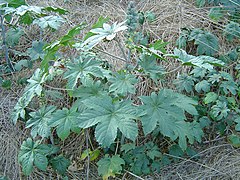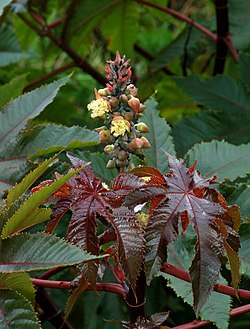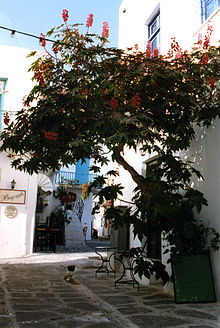
| Home | Sources Directory | News Releases | Calendar | Articles | | Contact | |
Castor oil plant
| Castor oil plant | |
|---|---|
 |
|
| Castor bean in disturbed area | |
| Scientific classification | |
| Kingdom: | Plantae |
| Phylum: | Magnoliophyta |
| Class: | Magnoliopsida |
| Order: | Malpighiales |
| Family: | Euphorbiaceae |
| Subfamily: | Acalyphoideae |
| Tribe: | Acalypheae |
| Subtribe: | Ricininae |
| Genus: | Ricinus |
| Species: | R. communis |
| Binomial name | |
| Ricinus communis L. |
|
The castor oil plant, Ricinus communis, is a species of flowering plant in the spurge family, Euphorbiaceae. It belongs to a monotypic genus, Ricinus, and subtribe, Ricininae. The evolution of castor and its relation to other species is currently being studied.[1]
Its seed is the castor bean which, despite its name, is not a true bean. Castor is indigenous to the southeastern Mediterranean Basin, Eastern Africa, and India, but is widespread throughout tropical regions (and widely grown elsewhere as an ornamental plant).[2]
Castor seed is the source of castor oil, which has a wide variety of uses. The seeds contain between 40% and 60% oil that is rich in triglycerides, mainly ricinolein. The seed contains ricin, a toxin, which is also present in lower concentrations throughout the plant.
Another plant species, Fatsia japonica, is similar in appearance and is known as the false castor oil plant.
Contents |
[edit] Description
Although monotypic, the castor oil plant can vary greatly in its growth habit and appearance. The variability has been aggravated by breeders who have selected a range of cultivars for leaf and flower colours, and for oil production. It is a fast-growing, suckering perennial shrub which can reach the size of a small tree (around 12 metres / 39 feet), but it is not cold hardy.
The glossy leaves are 15'45 centimetres (5.9'18 in) long, long-stalked, alternate and palmate with 5'12 deep lobes with coarsely toothed segments. In some varieties they start off dark reddish purple or bronze when young, gradually changing to a dark green, sometimes with a reddish tinge, as they mature. The leaves of some other varieties are green practically from the start, whereas in yet others a pigment masks the green colour of all the chlorophyll-bearing parts, leaves, stems and young fruit, so that they remain a dramatic purple-to-reddish-brown throughout the life of the plant. Plants with the dark leaves can be found growing next to those with green leaves, so there probably is only a single gene controlling the production of the pigment in some varieties at least.[3] The stems (and the spherical, spiny seed capsules) also vary in pigmentation. The fruit capsules of some varieties are more showy than the flowers.
The flowers are borne in terminal panicle-like inflorescences of green or, in some varieties, shades of red monoecious flowers without petals. The male flowers are yellowish-green with prominent creamy stamens and are carried in ovoid spikes up to 15 centimetres (5.9 in) long; the female flowers, born at the tips of the spikes, have prominent red stigmas).[4]
The fruit is a spiny, greenish (to reddish purple) capsule containing large, oval, shiny, bean-like, highly poisonous seeds with variable brownish mottling. Castor seeds have a warty appendage called the caruncle, which is a type of elaiosome. The caruncle promotes the dispersal of the seed by ants (myrmecochory).
[edit] Nomenclature
The name Ricinus is a Latin word for tick; the seed is so named because it has markings and a bump at the end which resemble certain ticks. The common name "castor oil" probably comes from its use as a replacement for castoreum, a perfume base made from the dried perineal glands of the beaver (castor in Latin). It has another common name, palm of Christ, or Palma Christi, that derives from castor oil's ability to heal wounds and cure ailments.
[edit] Habitat, growth and horticultural uses
Although castor is indigenous to the southeastern Mediterranean Basin, Eastern Africa, and India, today it is widespread throughout tropical regions.[2] In areas with a suitable climate, castor establishes itself easily as an apparently "native" plant and can often be found on wasteland.
It is also used extensively as a decorative plant in parks and other public areas, particularly as a "dot plant" in traditional bedding schemes. If sown early, under glass, and kept at a temperature of around 20 –C (68 –F) until planted out, the castor oil plant can reach a height of 2'3 metres (6.6'9.8 ft) in a year. In areas prone to frost it is usually shorter, and grown as if it were an annual.[2] However, it can grow well outdoors in cooler climates, at least in Southern England, and the leaves do not appear to suffer frost damage in sheltered spots, where it remains evergreen.[citation needed] It was used in Edwardian times in the parks of Toronto, Ontario, Canada.[5]
[edit] Cultivars
Selections have been made by breeders for use as ornamental plants (heights refer to plants grown as annuals) and for commercial production of castor oil [4]
Ornamental varieties:
- 'Gibsonii' has red-tinged leaves with reddish veins and pinkish-green seed pods;
- 'Carmencita Pink' is similar, with pinkish-red stems;
- 'Carmencita Bright Red' has red stems, dark purplish leaves and red seed pods;
(all the above grow to around 1.5 metres (4.9 ft) tall as annuals)[2]
- 'Impala' is compact (only 1.2 metres / 3.9 feet tall) with reddish foliage and stems, brightest on the young shoots;
- 'Red Spire' is tall (2'3 metres/6.6'9.8 feet) with red stems and bronze foliage;
- 'Zanzibarensis' is also tall (2'3 metres/6.6'9.8 feet), with large, mid-green leaves (50 centimetres / 20 inches long) that have white midribs.[4]
Varieties for oil production:
- 'Hale' was launched in the 1970's for the State of Texas, USA. It is short (up to 1.2 m) and has several racemes.
- 'Brigham' is a variety with reduced ricin content adapted for Texas, USA. It grows up to 1.8m and has 10% of the ricin content of variety Hale.
- 'BRS Nordestina' was developed by Embrapa (Brazil) 1990 for hand harvest and semi-arid environments.
- 'BRS Energia" was developed by Embrapa (2004) for mechanized or hand harvest.
- 'GCH6' was developed by Sardarkrushinaga Dantiwada University (India), 2004. It is resistant to root rot and tolerant to fusarium wilt.
- 'GCH5' was was developed by Sardarkrushinaga Dantiwada University (India), 1995. It is resistant to fusarium wilt.
[edit] Plant-animal interactions
Ricinus communis is the host plant of the Common Castor butterfly (Ariadne merione), the Eri silkmoth (Samia cynthia ricini), and the Castor Semi-Looper moth (Achaea janata). It is also used as a food plant by the larvae of some other species of Lepidoptera, including Hypercompe hambletoni and the Nutmeg (Discestra trifolii).
[edit] Toxicity
The toxicity of raw castor beans due to the presence of ricin is well-known. Although the lethal dose in adults is considered to be 4 to 8 seeds, reports of actual poisoning are relatively rare.[6]. According to the 2007 edition of the Guinness Book of World Records, this plant is the most poisonous in the world.
If ingested, symptoms may be delayed by up to 36 hours but commonly begin within 2'4 hours. These include a burning sensation in mouth and throat, abdominal pain, purging and bloody diarrhea. Within several days there is severe dehydration, a drop in blood pressure and a decrease in urine. Unless treated, death can be expected to occur within 3'5 days, however in most cases a full recovery can be made.[7]
Poisoning occurs when animals ingest broken seeds or break the seed by chewing: intact seeds may pass through the digestive tract without releasing the toxin. Toxicity varies among animal species: 4 seeds will kill a rabbit, 5 a sheep, 6 an ox or horse, 7 a pig, 11 a dog, but it takes 80 to kill a duck.[8] The toxin provides the castor oil plant with some degree of natural protection from insect pests, such as aphids. In fact, ricin has been investigated for its potential use as an insecticide. The castor oil plant is also the source for undecylenic acid, a natural fungicide.
[edit] Modern commercial usage
Global castor seed production is around 1 million tons per year. Leading producing areas are India (with over 60% of the global yield), China and Brazil, and it is widely grown as a crop in Ethiopia. There are several active breeding programmes.
[edit] Production
India is world leader in castor bean production, followed by China and then Brazil.
| Top ten castor oil seed producers ' 11 June 2008 | ||||
|---|---|---|---|---|
| Country | Production (Tonnes) | Footnote | ||
| 830 000 | * | |||
| 210 000 | * | |||
| 91 510 | ||||
| 15 000 | F | |||
| 12 000 | F | |||
| 11 052 | ||||
| 5 000 | * | |||
| 4 900 | F | |||
| 4 500 | F | |||
| 3 500 | F | |||
| World | ' 1 209 756 ' | A | ||
| No symbol = official figure, P = official figure, F = FAO estimate, * = Unofficial/Semi-official/mirror data, C = Calculated figure A = Aggregate (may include official, semi-official or estimates); |
||||
[edit] Other modern uses
In Brazil, castor oil (locally known as mamona oil) is now being used to produce biodiesel. In rural areas, the abundant seeds are used by children for slingshot balls, as they have the right weight, size, and hardness.
The attractive castor seeds are used in jewelry, mainly necklaces and bracelets. This practice is highly dangerous, due to the extreme toxicity of the seeds, especially if the seedcoat is drilled for stringing.
Castor oil in a processed form, called Polyglycerol polyricinoleate--or PGPR, is currently being used in chocolate bar manufacture as a less expensive substitute to cocoa butter.
[edit] Historical usage
Castor seeds have been found in Egyptian tombs dating back to 4000 BC; the slow burning oil was used mostly to fuel lamps. Herodotus and other Greek travelers noted the use of castor seed oil for lighting, body ointments, and improving hair growth and texture. Cleopatra is reputed to have used it to brighten the whites of her eyes. The Ebers Papyrus is an ancient Egyptian medical treatise believed to date from 1552 BC. Translated in 1872, it describes castor oil as a laxative.
The use of castor bean oil in India has been documented since 2000 BC in lamps and in local medicine as a laxative, purgative, and cathartic in Unani, Ayurvedic and other ethnomedical systems. Traditional Ayurvedic medicine considers castor oil the king of medicinals for curing arthritic diseases.
Castor seed and its oil have also been used in China for centuries, mainly prescribed in local medicine for internal use or use in dressings.
It was used in rituals of sacrifice to please the gods in early civilizations.[citation needed]
Castor oil is known to have been used as an instrument of coercion by the paramilitary Blackshirts under the regime of Italian dictator Benito Mussolini. Dissidents and regime opponents were forced to ingest the oil in large amounts, triggering severe diarrhoea and dehydration, which could ultimately cause death. This punishment method was originally thought of by Gabriele D'Annunzio, the Italian poet and Fascist supporter, during the First World War. (See also: Castor oil: Use as a means of intimidation in Fascist Italy)
[edit] Common names
|
[edit] Gallery
|
Seedling showing prominent cotyledons |
|||
|
Ricinus communis, fruit and leaf, Cornell Plantations 2008 |
[edit] See also
[edit] References
- ^ "Euphorbiaceae (spurge) genomics". Institute for Genome Sciences. University of Maryland Medical School. http://www.igs.umaryland.edu/?q=content/euphorbiaceae-spurge-genomics. Retrieved 2009-03-09.
- ^ a b c d Phillips, Roger; Martyn Rix (1999). Annuals and Biennials. London: Macmillan. p. 106. ISBN 0333748891.
- ^ e.g. http://database.prota.org/publishedspeciesEn.htm
- ^ a b c Christopher Brickell, ed (1996). The Royal Horticultural Society A-Z Encyclopedia of Garden Plants. London: Dorling Kindersley. pp. 884'885. ISBN 0751303038.
- ^ Toronto Star, 9 June 1906, p. 17
- ^ Wedin, G.P., Neal, J.S., Everson, G.W., and Krenzelok, E.P. 1986. Castor bean poisoning. Am J Emerg Med. 4(3): 259-61. (abstract)
- ^ Ricinus communis (Castor bean) - Cornell University 2008. [1]
- ^ Union County College: Biology: Plant of the Week: Castor Bean Plant
[edit] Further reading
- Everitt, J.H.; Lonard, R.L., Little, C.R. (2007). Weeds in South Texas and Northern Mexico. Lubbock: Texas Tech University Press. ISBN 0-89672-614-2
[edit] External links
| Wikimedia Commons has media related to: Ricinus communis |
- Ricinus communis L. at Purdue University
- Castor beans at Purdue University
- Ricinus communis (castor bean) at Cornell University
- Ricinus communis in Wildflowers of Israel;
|
SOURCES.COM is an online portal and directory for journalists, news media, researchers and anyone seeking experts, spokespersons, and reliable information resources. Use SOURCES.COM to find experts, media contacts, news releases, background information, scientists, officials, speakers, newsmakers, spokespeople, talk show guests, story ideas, research studies, databases, universities, associations and NGOs, businesses, government spokespeople. Indexing and search applications by Ulli Diemer and Chris DeFreitas.
For information about being included in SOURCES as a expert or spokesperson see the FAQ . For partnerships, content and applications, and domain name opportunities contact us.










